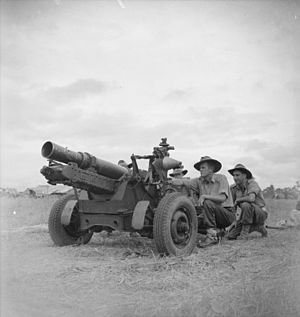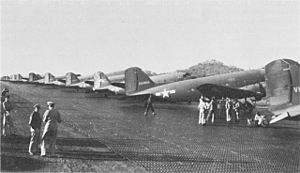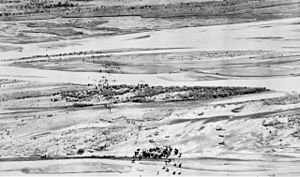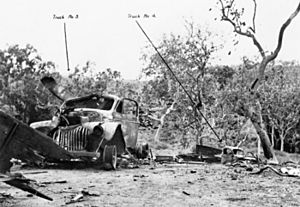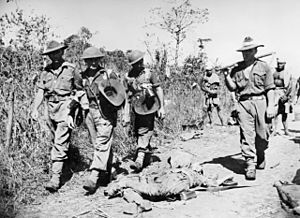Landing at Nadzab facts for kids
Quick facts for kids Landing at Nadzab |
|||||||
|---|---|---|---|---|---|---|---|
| Part of World War II, Pacific War | |||||||
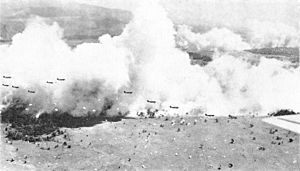 5 September 1943. Dwarfed by and silhouetted against clouds of smoke generated to provide concealment, C-47s from the US Army Air Forces drop a battalion of the 503rd Parachute Regiment at Nadzab, New Guinea. A battalion dropped minutes earlier is landing in the foreground. |
|||||||
|
|||||||
| Belligerents | |||||||
| Commanders and leaders | |||||||
| Strength | |||||||
| 6,000 | 2,000 | ||||||
| Casualties and losses | |||||||
| 119 killed 241 wounded or injured 166 evacuated sick. |
Unknown | ||||||
The Landing at Nadzab was an important military operation during World War II. It happened on 5 September 1943 in New Guinea. This event involved soldiers landing from the sky using parachutes. It was part of a bigger plan to capture the town of Lae.
The main part of the Nadzab operation was a large parachute jump. US Army paratroopers from the 503rd Parachute Infantry Regiment and Australian soldiers landed at Lae Nadzab Airport. General Douglas MacArthur, a very important Allied commander, watched the jump from a plane above. On the same day, Australian soldiers from the 2/2nd Pioneer Battalion and other units arrived at Nadzab after a long journey by land and river. They immediately started getting the airfield ready for more planes.
The next morning, the first transport planes landed. However, bad weather slowed down the arrival of more Allied troops. Over the next few days, the Australian 7th Division slowly gathered at Nadzab. Sadly, an air crash at Jackson's Field caused many Allied casualties, almost half of the total for the entire battle.
Once all the troops were at Nadzab, the Australian 25th Infantry Brigade began its march towards Lae. They fought Japanese soldiers at Jensen's Plantation on 11 September and won. Later, they defeated a larger Japanese force at Heath's Plantation. During this fight, Private Richard Kelliher earned the Victoria Cross, Australia's highest award for bravery. Instead of fighting for Lae, the Japanese Army decided to retreat over the Saruwaged Range. This was a very difficult journey for them, causing many losses from cold and hunger. The Australian troops reached Lae shortly before another Australian division, the 9th Division, which had been attacking Lae from a different direction.
After the battle, it was important to improve the road in the Markham Valley. This was a tough job because of the wet weather. The road finally opened on 15 December 1943. Nadzab then became the main Allied air base in New Guinea.
Contents
Why Nadzab Was Important
Allied Plans
In July 1942, the United States military decided to attack the Japanese base at Rabaul. This base was blocking Allied ships and planes from moving along the coast of New Guinea towards the Philippines. The main goal was to reduce the threat from Japanese aircraft and warships.
The Allied forces divided the Pacific theatre into two main commands. General Douglas MacArthur was in charge of the South West Pacific Area, which included Australia and New Guinea. Admiral Chester W. Nimitz commanded most of the rest of the Pacific. They had to work together because there was no single leader for both commands.
After some tough battles like the Guadalcanal Campaign and fighting in Papua, the Allies started winning. General MacArthur then pushed forward with his plans. In March 1943, the plans were discussed in Washington, D.C. They had to be made smaller because not enough resources were available. The capture of Rabaul was delayed until 1944.
On 6 May 1943, MacArthur's headquarters in Brisbane announced the new plan. It had three main parts for the New Guinea area:
- Take over Kiriwina and Woodlark Islands and build airfields there.
- Capture the Lae-Salamaua-Finschhafen-Madang area and build airfields there.
- Take control of western New Britain and build airfields.
The second part of the plan was given to General Sir Thomas Blamey's New Guinea Force. This meant that the Australian Army would do most of the fighting in 1943.
Japanese Plans
The Japanese had separate army and navy headquarters at Rabaul. They worked together but reported to different leaders. After a big defeat in the Battle of the Bismarck Sea, the Japanese decided not to send any more ships to Lae. Instead, they would land troops at Hansa Bay and Wewak and move them to Lae by barge or submarine. They also hoped to build a road through the Finisterre Range to Lae.
General Hitoshi Imamura ordered his general, Hatazō Adachi, to capture Allied bases like Wau. To help, the Japanese sent more air forces to New Guinea. By June, Adachi had about 80,000 soldiers in New Guinea. But like the Allies, the Japanese faced huge problems moving and supplying their troops.
The Area
The Markham River starts in the Finisterre Range and flows for about 180 kilometers (110 miles) into the Huon Gulf near Lae. The Markham Valley is between the Finisterre Range and the Bismarck Range. It is about 10 to 19 kilometers (6 to 12 miles) wide.
The valley floor is mostly gravel and not very fertile. Much of it was covered in tall grass, about 1.2 to 1.5 meters (4 to 5 feet) high. In some places, even taller grass, up to 2.5 meters (8 feet) high, grew. It rains about 1,000 millimeters (40 inches) per year. The Markham Valley could be used by vehicles in the dry season (December to April). This made it a natural route between the Japanese bases at Lae and Madang.
Getting Ready
At General Blamey's headquarters, the planning for the operation was led by Major General Frank Berryman. They even built a model of the Lae-Salamaua area to help with planning. On 16 May, Blamey discussed the details with his commanders.
Blamey's plan was to attack Lae from two sides. Major General George Wootten's 9th Division would land east of Lae by sea and advance. Meanwhile, Major General George Alan Vasey's 7th Division would attack Lae from the west by land. The 7th Division's main job was to block Japanese reinforcements from reaching Lae. Their second job was to help the 9th Division capture Lae. This plan was called Operation POSTERN.
At the same time, other Australian and US forces were ordered to attack Salamaua. This was to make the Japanese send troops there, drawing them away from Lae. This led to the difficult Salamaua Campaign.
The POSTERN plan said the 7th Division would travel by ship to Port Moresby. Then they would go up the Lakekamu River by barges and then by trucks. From there, they would march overland to the Markham River. They would cross the river with the help of paratroops and secure an airfield. Blamey chose Nadzab as the best airfield site.
General Vasey thought the plan was very difficult. The road they needed was not finished, and the 7th Division was not at full strength. Many soldiers were on leave or sick with malaria. It would take time to get them ready. To help, another unit was broken up to provide more soldiers. These new soldiers trained in conditions similar to New Guinea.
Because of delays, the 7th Division would need supplies by air at first. Vasey suggested that most of his troops fly directly to Nadzab. This made capturing Nadzab early even more important. MacArthur agreed to let the US 2nd Battalion, 503rd Parachute Infantry Regiment help capture Nadzab. They trained with the 7th Division. On 8 August, MacArthur allowed the entire 503rd Regiment to be used.
The 7th Division watched a training film about loading planes. General George Kenney's Fifth Air Force provided planes for the 7th Division to practice loading and unloading. General Vasey also flew over the target area to see it from the air. Meanwhile, Australian engineers practiced crossing rivers with special folding boats. They flew to Tsili Tsili Airfield in late August.
To give the paratroopers artillery support, some Australian gunners volunteered to drop their short 25-pounder guns by parachute. They practiced jumping, but getting the guns ready was harder. New guns had serious problems, and only one was ready in time for the jump.
Vasey was worried about the Japanese strength around Lae, which his staff estimated at 6,400 soldiers. A bigger danger was the Japanese Fourth Air Army at Wewak, which had many aircraft. On 17 August, Allied bombers attacked Wewak, destroying about 100 Japanese planes on the ground. This left the Japanese with only about 60 or 70 planes to fight the Allies in New Guinea.
On 4 September, Australian soldiers tried to capture Markham Point, a Japanese position near the Markham River. The attack went wrong, and the Australians suffered casualties. They decided to just surround the Japanese force instead.
The Battle Begins
The Airborne Attack
The planes for the operation were controlled by the 54th Troop Carrier Wing. The actual date for the attack, 5 September 1943, was chosen by General Kenney based on weather forecasts. He wanted clear weather for the flight to Nadzab but fog over New Britain to prevent Japanese planes from attacking.
On Z-Day, 5 September 1943, the weather was bad at first with fog and rain. But as predicted, the fog cleared. The first C-47 transport plane took off at 08:20. A total of 79 C-47s, each carrying 19 or 20 paratroopers, flew in three groups. They were escorted by many fighter planes.
General Kenney told General MacArthur he planned to watch the operation from a B-17 bomber. MacArthur reminded Kenney to stay out of danger, but Kenney insisted. MacArthur then said, "You’re right, George, we’ll both go. They’re my kids, too."
Three hundred and two aircraft from eight different airfields met over Tsili Tsili at 10:07. They flew through clouds and over mountains. General Kenney said, "Not a single squadron... slid into place like clockwork." First, 48 B-25 bombers attacked the drop zones, dropping bombs and firing machine guns. Then, seven A-20 planes laid smoke screens to hide the paratroopers.
Next came the C-47s, flying low and slow. The paratroopers started jumping at 10:22. All the soldiers were out of the planes in just four and a half minutes. After the transports, five B-17s dropped supplies to the paratroopers. Other bombers attacked Japanese positions near Lae. Generals MacArthur, Kenney, and Vasey watched the whole operation from their B-17s. MacArthur later received a medal for leading the paratroopers.
There were no Japanese planes to fight them. Only one C-47 had a problem and returned to base. Three paratroopers died during the jump due to parachute problems or bad landings. Another 33 had minor injuries. The paratroopers faced no resistance on the ground and quickly gathered in their meeting areas, despite the heat and tall grass.
Five C-47s carrying the Australian gunners of the 2/4th Field Regiment took off later. They dropped their men and then their dismantled guns. One Australian was injured. The gunners had to find and assemble their guns in the tall grass. They got one gun ready to fire within two and a half hours. It took three days to find parts and assemble the second gun.
Following Up
Meanwhile, an Australian force led by Lieutenant Colonel J. T. Lang, including engineers and local carriers, set out from Tsili Tsili on 2 September. They marched overland and met up with other Australian soldiers. A small group of engineers also traveled by boat down the Watut and Markham Rivers. These rivers were fast-flowing and dangerous, and three boats were lost. On the morning of 5 September, Lang's force saw the air attack happening overhead. They then built a pontoon bridge to cross the Markham River safely. That evening, they reached the American paratroopers.
The next day, these soldiers started working on the airstrip using hand tools. They cut down trees and filled potholes. They were supposed to get equipment like tractors and mowers by glider, but General Blamey cancelled this because he worried about the glider pilots. Instead, they cut the tall grass by hand and burned it. By 11:00 on 6 September, the airstrip was extended and ready.
The first plane to land was a small L-4 Piper Cub. Then, three transport planes landed, almost hitting workers on the strip. More planes arrived that afternoon, bringing American and Australian engineers. The next day, bulldozers and graders arrived. They found a new, even better site for an airstrip. This site was an old, dry riverbed with lots of gravel. They laid a gravel base and steel planks to make it suitable for fighters. By the end of October, Nadzab had four airstrips, one of which was 6,000 feet (1,800 meters) long and paved.
On 7 September, a terrible accident happened at Jackson's Airfield. A B-24 Liberator bomber crashed shortly after takeoff, killing all eleven crewmen. The plane exploded, spraying burning fuel onto five trucks carrying Australian soldiers from the 2/33rd Infantry Battalion. Many soldiers were killed or injured; 15 died instantly, 44 later died from their wounds, and 92 were injured. Despite this tragedy, the remaining soldiers flew to Tsili Tsili as planned.
Because of the unpredictable weather, planes arrived at Nadzab slowly. By the morning of 8 September, only two Australian battalions had reached Nadzab. General Vasey ordered the advance on Lae to begin. More planes arrived in the following days, finally bringing all the Australian troops to Nadzab by 12 September.
On 13 September, a group of Australian soldiers came under heavy fire from a hidden Japanese machine gun near Heath's Plantation. Private Richard Kelliher bravely ran towards the gun, threw two grenades, and then used a Bren gun to silence it. He then went back under fire to rescue a wounded soldier. For his amazing bravery, Kelliher was awarded the Victoria Cross.
North of the main advance, a US paratrooper patrol met about 200 Japanese soldiers on 15 September. The Americans fought them and reported causing many losses. The arrival of more Australian troops at Nadzab allowed the paratroopers to finally rest.
By this time, the 9th Division was very close to Lae, while the 7th Division was still about 7 miles (11 kilometers) away. It looked like the 9th Division would reach Lae first. The 7th Division continued its advance on 16 September. They killed the last Japanese soldiers blocking their path and moved towards Lae. As they marched, they sometimes found sick Japanese soldiers. The Australian commander, Brigadier Ken Eather, urged his troops to hurry. He even walked ahead as a scout. The Australian column entered Lae without Japanese resistance. However, planes from the Fifth Air Force mistakenly attacked the Australian soldiers, wounding two men. General Vasey quickly sent a message to stop the attack, and the artillery fire from the 9th Division also stopped.
Japanese Retreat
On 8 September, the Japanese commander, Adachi, ordered his troops to leave Salamaua and retreat to Lae. By 11 September, the main Japanese force began to withdraw. It became clear that the Allies planned to trap the Japanese 51st Division. After talking with headquarters in Tokyo, the Japanese leaders cancelled their plans to capture other Allied bases. They ordered their troops to move overland to the north coast of the Huon Peninsula.
The Japanese soldiers from Salamaua gathered at Lae on 14 September. Over the next few days, the Japanese left Lae. The retreating Japanese soldiers were the ones encountered by the US paratroopers. The Japanese quickly changed their route to avoid the Australians.
Crossing the Saruwaged Range was incredibly difficult for the Japanese soldiers. They started with ten days of food, but it ran out quickly. Many soldiers threw away their heavy equipment, even their rifles. One Japanese general wrote that the crossing took much longer than expected and was "beyond discussion." It was intensely cold near the mountain tops, and soldiers could only doze by fires. They faced squalls and even snow in the tropical mountains. The slopes were so steep that many men fell to their deaths.
In the end, the Japanese Army managed to retreat, but they suffered huge losses from cold, hunger, and exhaustion.
What Happened Next
Casualties
The US 503rd Parachute Infantry Regiment lost three men killed and 33 injured during the jump. Another eight were killed and 12 wounded in fighting, and 26 became sick. The Australian 7th Division reported 38 killed and 104 wounded between 5 and 19 September, with another 138 evacuated due to sickness.
The air crash at Jackson's Airfield added to the casualties: 11 Americans and 59 Australians were killed, and 92 Australians were injured. In total, 119 Allied servicemen were killed, 241 wounded or injured, and 166 became sick. Japanese casualties were estimated at 2,200, but it's hard to say how many were from fighting the 7th or 9th Divisions.
Building the Base
Developing Nadzab into a major base needed heavy construction equipment. This equipment had to be brought to Lae and then moved along the Markham Valley Road. The 842nd Engineer Aviation Battalion was assigned to improve the road. They arrived at Lae on 20 September but were soon sent to Nadzab.
The 842nd reached Nadzab on 4 October. However, heavy rain and constant military traffic ruined the road, forcing supplies to be flown to Nadzab from Lae. The engineers had to restart work on the road from the Nadzab end. It rained on 46 of the next 60 days. The road finally reopened on 15 December. This allowed more engineer battalions to move to Nadzab and work on building the airbase.
Eventually, Nadzab had four all-weather airfields. One had two runways, one paved with steel matting and another with bitumen. Another had a partially paved runway. The third had a long runway paved with bitumen and steel matting. The fourth, an Australian airfield named Newton, had two parallel runways paved with bitumen. Nadzab became the main Allied air base in New Guinea.
The Outcome
General Blamey called the capture of Lae and Salamaua "a clear step on the road to Victory." The airborne operation at Nadzab was seen as a perfect example of a parachute attack in World War II. It showed how valuable airborne operations could be.
The impact of Nadzab was much bigger than the Allies realized at the time. The Japanese military headquarters had seen earlier defeats as minor setbacks. But after Nadzab, they concluded that their forces were spread too thin. They drew a new defensive line further back, through Western New Guinea and the Caroline Islands. From then on, Japanese forces outside this new line were meant to hold on as long as possible, just to delay the Allied advance, not to win a decisive victory.
Images for kids


